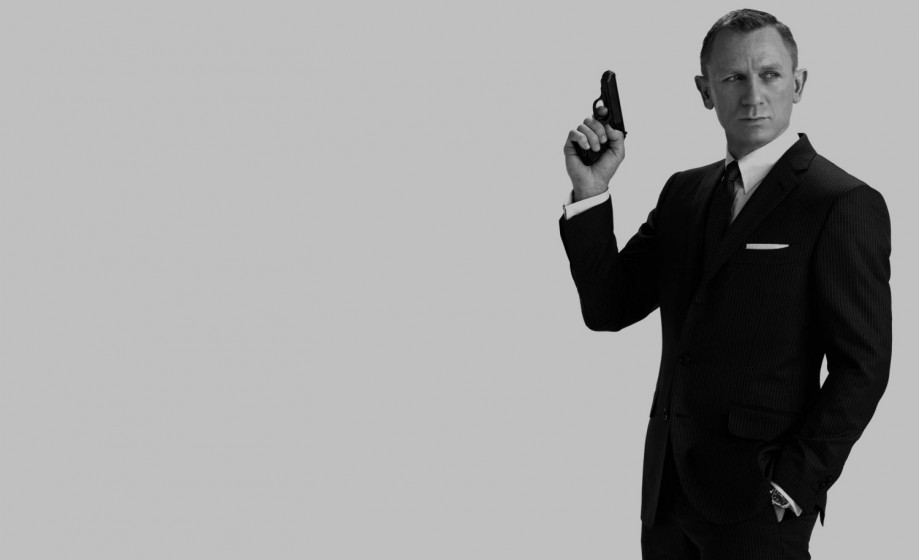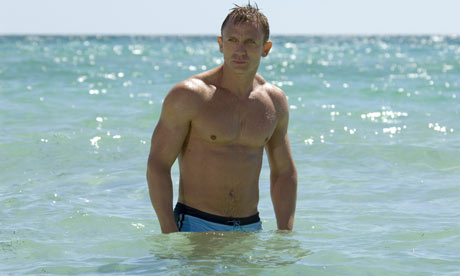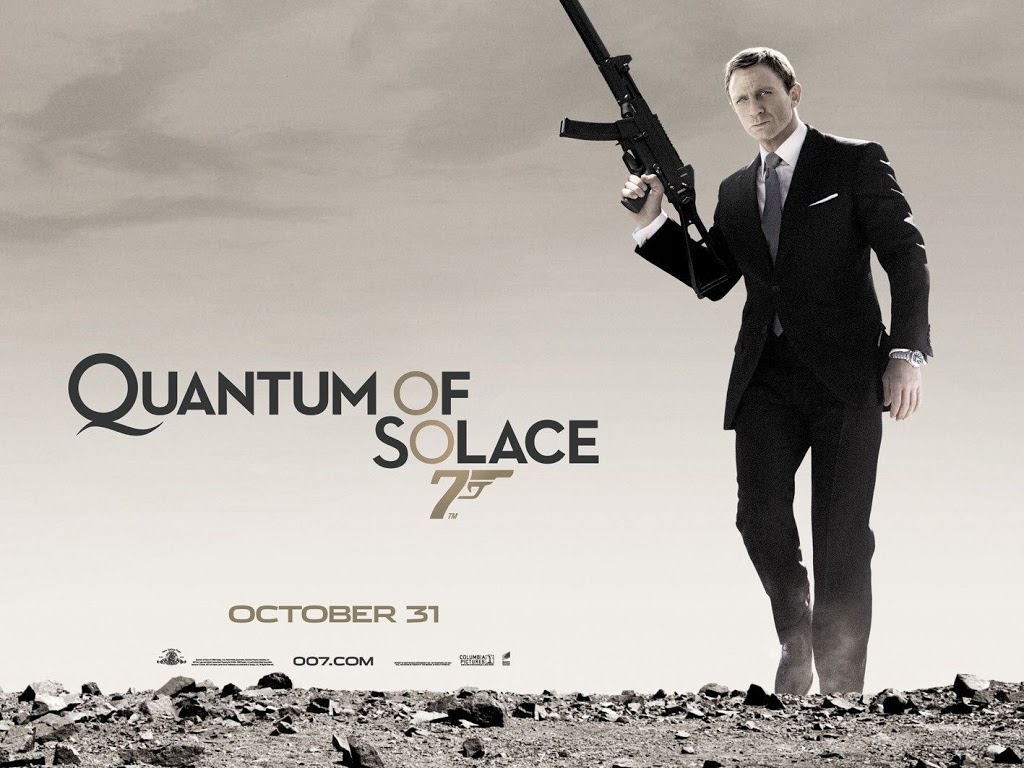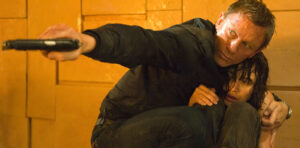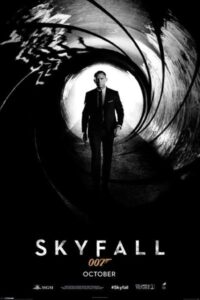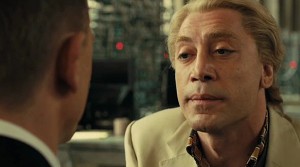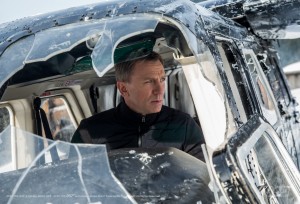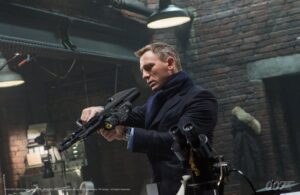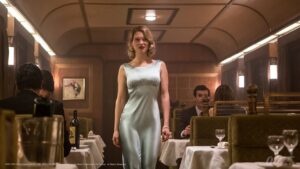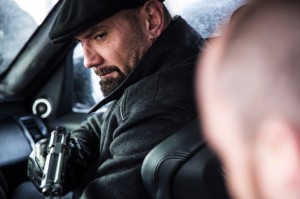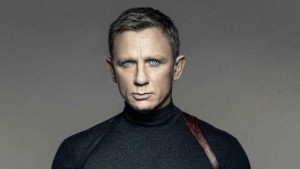Daniel Craig arrived with a flourish typical of a new Bond at a press conference on the banks of the Thames. The actor had proclaimed his tough guy credentials in a zippy crime drama called Layer Cake, and looked comfortable with props (like guns) in Munich, but seemed far from a shoo-in for the role of James Bond. For one, he’s blonde. And what about all those other actors who were considered? For years, since probably Croupier, Clive Owen was very much in the running. How the actor looks in the tux is very important, after all.
When Casino Royale finally arrived, the world was a very different place. Not just that four years had passed since the last Bond. Not just that it was a post-9/11 world in a way that would need to be reflected in a spy movie with any grounding in realism. The biggest change since Die Another Day was the arrival of The Bourne Identity and its sequel, The Bourne Supermacy. The Matt Damon thrillers had not only brought the spy genre into the 21st Century with a cold intensity, they had changed the very language of action movies. Director Paul Greengrass’ signature kinetic and dynamic style, and Damon’s meaty physicality, meant this new Bond movie would have to be very good to not feel outpaced, a relic of another time.
Good thing, then, that it is very good. One of the best. Be prepared: spoilers abound from here on.
Casino Royale (2006) | Directed by Martin Campbell | Written by Neal Purvis, Robert Wade and Paul Haggis, based on the character by Ian Fleming | 144 min
Casino Royale brings Bond back to his beginnings. He’s only just qualified for his 007 status, his license to kill, with a messy, brutal, fight in a bathroom, shot in high-contrast, gritty black and white and intercut with a Prague office showdown, Bond ending the life of a thieving government agent, also in B&W.
Then we have a gorgeous credit sequence, with the unfairly maligned Chris Cornell song “You Know My Name” playing, actually a perfect, adrenalized rocker with a percussive opening that recalls John Barry’s many Bond themes.
We waste no time; the first act is launched by an astonishing, parkour-based action sequence with amazing crane jumping like nothing we’ve seen in Bond before. Within minutes, not only does Craig perform startling physical feats, establishing his bona fides as a believable action man, we have a sequence as much fun as anything in the Bourne movies. And Bond ruthlessly kills his unarmed quarry. Smooth and sophisticated, he is not.
M is Judi Dench, a carryover from the Brosnan films, maybe a bit tougher on the “blunt instrument” that is this new, more thuggish, cockier Bond. (No Miss Moneypenny or Q, yet.) Tellingly, director Martin Campbell introduced Pierce Brosnan as Bond in Goldeneye), and does well to update the mythos a second time.
We have Bond in a bathing suit, upending the Honey Ryder/Jinx imagery, perhaps hoping to appeal to Bond’s female fans, or cultivating a new gay audience? It’s hard to imagine Bond as a gay icon, but stranger things have happened. Maybe Bond’s been over-compensating for something all these years.
He wins a classic Aston Martin in a game of chance in Barbados, drives it for about a minute. Chasing bad guys, he travels to Miami, and then to Montenegro, to play a high-stakes poker game (Baccarat is way too 20th Century) against Le Chiffre (the super-creepy Mads Mikkelsen), hoping to bankrupt this international terrorist organization. The purse strings for the crown are held by Vesper Lynd (Eva Green is astonishing in the role, witty and cerebral and very much Bond’s equal).
Craig is everything he needs to be: grim, athletic, and maybe the best actor to yet essay Bond. He shows the complex layers of the man, a boyish impudence along with a relentless determination to do the job required, along with the required fearlessness. When there are quips, they’re cold and lacerating, not jokey. Casino Royale is closest in tone to From Russia With Love, On Her Majesty’s Secret Service and For Your Eyes Only. Good company.
The romance with Vesper is electric, as is the finale, where we finally are given a psychological reason for Bond’s distrust of women. This is a much more emotional character, while still being very recognizably 007. There are unexpected action sequences, brutal violence, and a new Aston Martin, too (though it sadly bites the dust). And the famous Monte Norman theme? It finally appears in the final sequence, as does the famous line: “Bond, James Bond.”
All in all, it’s a keeper. Were I to recommend a Bond movie to a neophyte, this is the one.
Quantum of Solace (2008) | Directed by Marc Forster | Written by Paul Haggis and Neal Purvis | 106 min
This 22nd Bond disappointed me when I saw it in the cinema. A second viewing on DVD revealed more pleasures than I’d originally noticed, and the couple of times I’ve watched it since more of its incidental pleasures have revealed themselves. It’s actually not a bad entry in the 007 canon, it’s just a somewhat more slight relative to the one just before, which was such an impressive first time at bat for the new Bond.
Quantum is the first immediate sequel in the history of the franchise. I’m not sure that was the best choice. Fine to keep Mr White (Jesper Christensen) and the mysterious Quantum organization in the picture, a la SPECTRE, but to continue it almost immediately following the end of Casino Royale feels a bit rushed from the get-go.
Odd that, if the opening sequence — a solid car chase along the Italian coastline — takes place not long after the conclusion of Casino Royale, that Bond seems to be wearing a different suit.
Turns out the bad guy this time out is a man, Dominic Greene (Mathieu Amalric), who wants to take control of the water supply of Bolivia, so stages a coup with the help of Mr White’s Quantum organization. I suppose as far as megalomaniacal plans go it has a certain style, but he has no real henchman, and isn’t much of a physical threat to Bond. He’s slippery, but a villain as diminutive as he is should have muscle, too.
We do have the return of Rene Mathis (Giancarlo Giannini), the friend-or-foe contact from Casino Royale who brings a bit of old-world flavour, as well as the best Felix Leiter yet, the excellent Jeffery Wright, who suffers in his position working for the CIA given the agency’s role in covert American foreign policy. He and Bond share one of the best written scenes in the movie, crystallizing both their personal friendship and their nations’ sometimes competing interests.
“Bond Girls” include Olga Kurylenko as Camille, a woman looking for revenge on Greene and his military compatriots for past atrocities, and Strawberry Fields (only called Fields in the film, but the end credits give up the ginger’s double-entendre handle), a British agent played by Gemma Arterton.
The conclusion at a strangely explosive hotel in the desert isn’t one of the series’ best, and neither is a sequence where Bond and Camille escape a crashing plane. However, Bond slipping out of MI:6’s grasp with ease at the hotel in La Paz to pursue Greene is a great moment, and the location cinematography is typically excellent. The different fonts for each international city is a bit heavy handed (but fun), and the action sequences don’t disappoint.
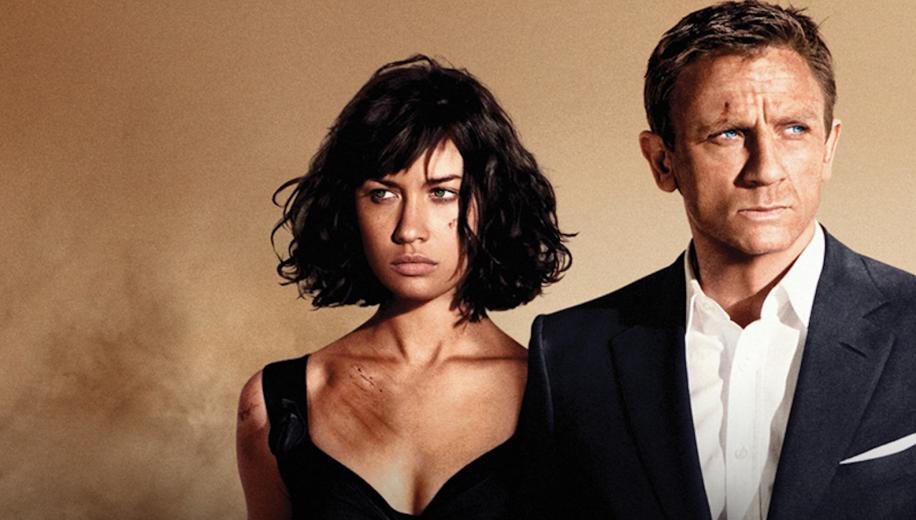
I just wish there was a little more at stake beyond the water rights of Bolivia.
Whatever its problems, what really resonates in Quantum of Solace is Craig: he proves that Casino Royale was no fluke, he is Bond right to the bone. And we all get some satisfaction at the end with the Vesper Lynd affair tied off for good.
Skyfall (2012) | Directed by Sam Mendes | Written by Neal Purvis, Robert Wade and John Logan | 142 min
James Bond returns for the 23rd time (in an EON Productions film), the third time for Daniel Craig. Since he took the mantle of the most famous secret agent in the world (something of an obstacle to his job’s requirement of anonymity, I’d imagine), and the producers have cleverly allowed for a bit of self-awareness to creep into the frame. Not so much that it becomes a joke — see the egregious opening of On Her Majesty’s Secret Service when new Bond, George Lazenby, breaks the fourth wall with his, “This never happened to the other fellow.” But, after so many instalments, it’s fair to assume your audience will get the in-jokes and subtle references.
It’s also fair to assume audiences can handle something new added to the 007 formula. Sure, there are (at least) two ladies with which he jousts, a number of exotic locales, and a vodka martini, shaken (not… you know). There’s also a greater show of emotion from the Crown’s hired gun, an exploration of his relationship with his boss, and an acknowledgement he’s had a hard road — he’s not a young man anymore.
Most of this is fine, this tilling of the soil. Some of it goes a bit too far, but director Sam Mendes brings authenticity to all of it, to both the action sequences and the character work, making for an extraordinary entry in the Bond franchise. It won’t topple Casino Royale as the best of the Craig era, but it’s tons of fun.
While there’s no opening gun-barrel sequence — don’t worry, it’ll show up — the requisite jaw-dropping chase disrupting a world-class city? Check.
However, Mendes gets one demerit point for shooting on the rooftops above the Grand Bazaar in Istanbul. It’s been done before: I’m pretty sure it’s where the 2009 Bond-esque thriller The International starring Clive Owen concluded. Bond is in pursuit of a man who has taken from MI:6 a hard drive containing a list of agents in the field. In trying to locate it, Bond is terribly wounded by a fellow agent, Eve (Naomi Harris).
Or so we (and his superiors) are led to believe. Actually he’s off living on a beach somewhere with a beautiful, nameless woman. He’s scarred, sure, but who wouldn’t be? Drinking games with scorpions make up his nightlife. An attack on the MI:6 building in London brings him back to the world. Someone has a personal beef against boss-lady M (Judi Dench), and our villain is a superior hacker who has the hard drive and that list. He’s got the secrets the agency fights so hard to protect. It’s making M look bad to the politicos, a situation outlined by bureaucrat Gareth Mallory (Ralph Fiennes).
Bond certainly has plenty of reason for griping with M, too. She ordered the shot that took him out. She sends her men off to die all the time. She said as much in Goldeneye. But Bond’s beefs don’t extend to this maternal figure. He’s too in love with duty. And maybe death.
We get to meet the new Quartermaster, or as we know him, Q. A much younger man this time out, nerdy even, but a rich character essayed by the wonderful Ben Whishaw.
Mendes’ and the screenwriters’ knowledge of the Bond mythos makes for lots of fun through the running time, with plenty of nods to movies past. The ones I recognized included Goldfinger, For Your Eyes Only, You Only Live Twice, reptile hopping from Live & Let Die, Goldeneye exploding pen reference, and a bottle of 50-year-old Macallan Scotch, just to remind us of Bond’s anniversary. Oh, and there’s a personalized gun, just like Bond received back in Licence To Kill.
There are other references too, maybe accidental. How much does Skyfall borrow from Christopher Nolan films such as The Dark Knight? The fey villain (in this case, Javier Bardem’s Silva), allowing himself to be captured as a mid-movie centerpiece, all a part of his plan. The night shots of a Chinese metropolis from the air and a deserted island city (actually located near Nagasaki, Japan), not unlike the final dream level in Inception.
This is not a complaint, mind you. Nolan has been inspired by Bond for years, so it makes sense that the influence should boomerang and with it the implication that Nolan should direct one of these.
So, yes, nothing I’ve mentioned so far is criticism. The action sequences are superb, Craig is more grizzled, more the single-minded dog of war than ever, while still managing to show vulnerability, even if it’s mostly his physical wear and tear and his wildly haunted eyes. The locations are well-established, especially the sequences in China (though I doubt very much they actually sent actors to Shanghai or Macau). The sets are convincing, either way.
And Skyfall has something the less successful Quantum of Solace did not: an excellent villain. Silva has Bond’s cleverness, combined with an abandoned child’s need for recognition. In some moments Bardem seems to be channeling the late, great Raul Julia, with added flourish. Watch how he throws grenades.
If there is a misstep, it’s in the final act. I’ll allow that the scripts since Casino Royale and Craig’s talent as a performer have given his character a bit more depth, but I think it’s a mistake to reveal too much about James Bond: you risk his universal appeal. As far as an architypical male fantasy goes, it’s much easier to project yourself on a man of mystery, much easier to adapt him.
At the end of Skyfall they take it too far, introducing a caretaker (a bewhiskered Albert Finney) and a homestead. The sentiment is slathered on too thick, and James Bond isn’t Bruce Wayne, the traumatized orphan. It also further diminishes the film’s thrills with a somewhat ordinary final action sequence involving flashlights, unexpectedly deep, ice-covered ponds, and tears.
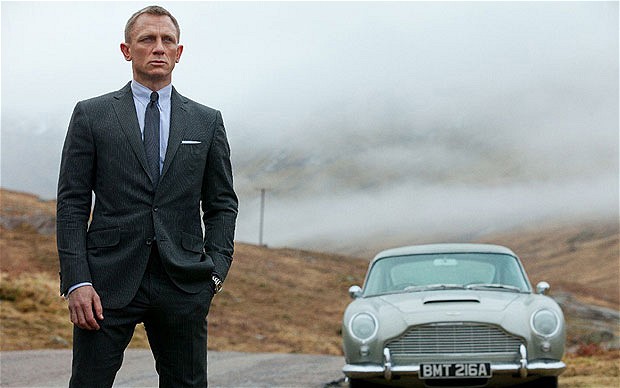
But it’s a testament to the skill of the actors and filmmakers; this ill-advised trip into Bond’s past doesn’t capsize the effort as a whole. A well-timed, well-delivered quip — ”I always hated this place” — and exploding helicopters help save the day.
Longtime Bondophiles will find even more to enjoy in the final scene, one that sets up future instalments with an eye to tradition.
Spectre (2015) | Directed by Sam Mendes | Written by John Logan, Neil Purvis, Robert Wade, and Jez Butterworth | 148 min
“Bond is back… and this time, it’s personal!” This could have been the cheekily lame tagline for each of the four Daniel Craig James Bond films, starting with Casino Royale in 2006. That was an origin story of sorts, and it handily explained some of the British secret agent’s psychological underpinnings, including his problems with commitment. It was the best of the bunch (so far) for offering a fresh slate to the character while reinforcing why, at his core, he is his job.
But in every film since—including Quantum of Solace, Skyfall, and now Spectre, they’ve doubled down on some personal connection in Bond’s past, and each time it hasn’t really worked. For decades the superspy has been embraced at least in part because his beginnings are suggested but unknown, which allows audiences to read into him. It’s called mystique, an increasingly elusive quality in our over-sharing era.
Bond’s most defining and appealing characteristic is his devotion to Queen and Country, above all else. It explains and even excuses his ruthlessness. Maybe that’s old hat to some, but needing to connect some plot twist or some enemy to Bond’s private life (such as it is) frequently feels trite, even as it provides a measure of psychological foundation.
That might be my biggest complaint about the Craig Bonds, a series I’ve for the most part really enjoyed. They’ve certainly proved more memorable than the interchangeable Brosnan films.
I’ll get into the parts of Spectre I liked (and a few more things I didn’t) in a moment, but be warned: I’m tossing aside any effort at concision, and will be going into spoilers. Maybe see the picture, then come back for the rest of this.
We first happen on Bond in Mexico City, with a bravura tracking shot from within a Day Of The Dead carnival, into an elevator in the Gran Hotel Cuidad and onto the roof of the building. I suspect there’s a lot of digital knitting and green screen going on. That leads to a chase through the streets and into a helicopter over the immense Zocalo square — this might be the most impressive pre-credit sequence in the 50+ years of this franchise.
Turns out Bond is there on a personal mission — cued by a message from the former M (Judi Dench) —and it puts 007 in hot water with the current M (Ralph Fiennes) who’s under pressure from M’s counterpart at MI:5, Max, also known as C (Sherlock’s Andrew Scott, whose presence here is a bit of a reminder that Spectre could use a lot more of the cleverness baked into that other gig of his). The British government has decided to merge MI:5 and MI:6, and conclude the Double-Oh program in favour of investing in communications surveillance. Why have a man in the field when they can collect all the information they need with a laptop?
This changing, Snowden-esque motif is a rich one to explore, but the film only pays lip service to the idea. Later on, when we discover the connections between C and our real villain, their plan is never fully explained. We sort of have to take it on faith they’re the bad guys.
Speaking of taking things on faith, why (former) M chose to save this key mission for Bond is never made clear. But, it must be said, Bond movies have never hinged too heavily on elucidating the plot. So long as 007 seems to know what’s going on, we should trust it all to come clear later. The pleasure is in the process.
And there is plenty of to enjoy in that. Mendes, freed up by a larger budget and more international locations due to Skyfall‘s success, and having DP Hoyte Van Hoytema (Interstellar, Her) on board, has made maybe the most beautiful Bond movie ever. The first act — moving from Mexico to London and then to Rome — has an operatic gorgeousness to it, in the lighting, wardrobe, and the score.
We also visit with Q (Ben Whishaw), who provides Bond with a brand new Aston Martin loaded with lethal additions. Not only is the car sexy as hell, it’s a tacit acknowledgment of why we’ve loved these movies in the past — a playfulness and a sense of scale embraced in movies like The Spy Who Loved Me. (Funny that Bond also gets a watch that goes boom, since Q said in Skyfall about an exploding pen, “we’re not really into that anymore.”)
But then Mendes shoots one of the dullest car chases in recent action movie history. Just take a look at any of the past three Fast & Furiouses, this summer’s Mission: Impossible — Rogue Nation, or even the opening of Quantum to see far more exciting automotive mayhem. Mendes biggest mistake is staging its conclusion largely off-camera, making Bond look like he’s stepped into an ad for high-end chocolates.
Worse, we have a terrific couple of scenes with the legendary Monica Bellucci, only to have her vanish from the movie entirely. What a waste. I suppose the fact she doesn’t die is some kind of structural improvement given the fate of many of the female characters Bond woos in these movies.
The more substantial female lead is Léa Seydoux’s Madeleine Swann, who has a terrific, smoky look, but she and Craig have no chemistry to speak of — a scene on a train mirroring the introduction of Vesper Lynd in Casino Royale has none of the former film’s sexy frisson. Bond’s so-called obligation to her feels like thin motivation, which would have been fine if it’s revealed he was doing it to get to the organization behind all of it, but apparently he feels he should provide some kind of protection to the daughter of one of his worst enemies.
The callbacks to tradition in the series are fun. I liked that a physically impressive though largely silent henchperson is on the scene, Dave Bautista’s Mr Hinx — whose name is never actually spoken. And the mountaintop spa and plane/car chase down the side of the hill is a thrilling throwback to On Her Majesty’s Secret Service.
When we finally get a showdown between Bond and the Big Bad (Christoph Waltz at his most anodyne), it’s a fizzle. Waltz more whiny than threatening, the villain lair location doesn’t impress especially, and Bond and Swann escape far too easily.
The need to explain/obscure our villain’s identity — Blofeld after all, white cat included — is a total Cumberbatch As Khan trick, and just as lame. Casual Bond fans won’t care, and the hardcore can see it coming a mile off. What was the point? And Bond’s shoe-horned personal connection to the villain is entirely unnecessary. It makes Blofeld’s motivation less a grand, megalomaniacal, world-conquering thing and more a low filial spite, which cheapens it.
The screenwriters are happy to play connect-the-dots with the familiar in the franchise without bringing much that feels genuinely new. There are a few more gags this time around, which is the right way to go, but I wouldn’t call it actual wit. It’s a tricky balance, I’ll acknowledge, to be both true to the mythos and advance them. Spectre is a bigger Bond in many ways, and some of that is undoubtably entertaining, but I wish it felt more essential.
This is especially true in the last act, concluding with a bomb, a boat, and yet another helicopter. There’s something about having Bond face representations of the dead that I appreciate — it reminds me of something out of the British spy series The Avengers, a thematic peer to Bond from the 1960s. And final sequence on Westminster Bridge, where he chooses not to employ his license to kill, was probably the right decision. But, by this point, everything feels a little slack.
Having, once again, reestablished Bond and his raison d’etre at the end of Skyfall, what are we supposed to take from his apparent happiness, driving off into the sunrise at Spectre‘s end? It feels counter-intuitive. It’s an inalterable truth about his character: He’s only happy when he’s working OHMSS.
For reviews of James Bond 007 going further back in the series, click on these links: The Sean Connery Era, On Her Majesty’s Secret Service, The Roger Moore Era, The Timothy Dalton Era and The Pierce Brosnan Era.
And for the review of the final movie where Daniel Craig is James Bond, No Time To Die, go here.





